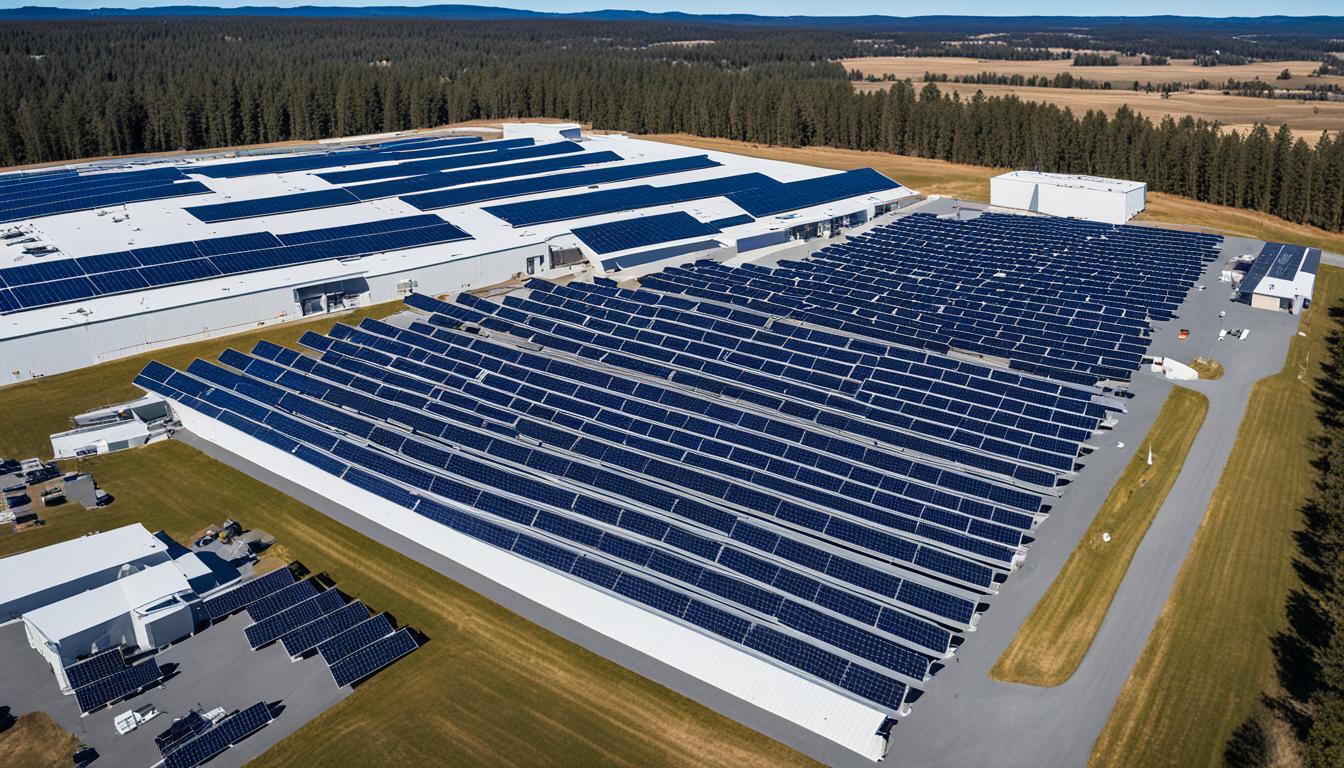
The development of solar energy has become a critical component in the transition towards a net-zero energy grid. As the demand for utility-scale renewable energy continues to grow, understanding the process of solar power plants is essential. From harnessing sunlight to producing electricity, let’s explore the intricate steps involved in converting solar energy into a sustainable power source.
Key Takeaways:
- Solar power plant development plays a significant role in achieving a net-zero energy grid.
- Understanding the process of converting solar energy into electricity is crucial for the advancement of utility-scale renewable energy.
- The Bureau of Land Management (BLM) is actively involved in land protection and the development of solar energy projects.
- Legislation is being introduced to increase transparency in grid operator votes, ensuring alignment with public interests.
- Liquidity challenges in the solar energy sector, like delays in payments, can impact companies’ ability to enhance shareholder value.
The Call for Transparency: Revealing Votes at the Grid Operator
Lawmakers in multiple states, including Maryland, Virginia, Illinois, and West Virginia, are introducing legislation to require electric utilities to disclose their votes at PJM, the nation’s largest regional transmission organization. These bills aim to provide transparency regarding lower-level committee votes by utilities that impact electric market rules, participation of renewable energy resources, and transmission planning. The bills seek to ensure that utilities’ votes align with public interests, especially as many states pursue clean energy goals.
Currently, the voting process at PJM is not easily accessible to the public, requiring registration for virtual meetings and offering limited information on voting outcomes. Advocates argue that understanding utility votes is crucial for assessing if utility actions align with their public statements on supporting clean energy.
While the bills have been primarily pushed by Democratic lawmakers, transparency in grid operator votes should be a bipartisan concern.

The Need for Transparency
“Understanding utility votes is crucial for assessing if utility actions align with their public statements on supporting clean energy.”
Transparency is a fundamental aspect of democracy, and when it comes to crucial decisions surrounding the electrical grid operator, it becomes paramount. By revealing the votes of electric utilities at PJM, the public can hold these entities accountable for their actions and ensure that their interests align with the pursuit of a clean and sustainable energy future.
Requiring disclosure of grid operator votes promotes trust and allows stakeholders, including environmental organizations, renewable energy advocates, and concerned citizens, to evaluate the decision-making process. It enables a comprehensive understanding of the factors influencing electric market rules and the integration of renewable energy resources, ultimately leading to a more transparent and inclusive energy sector.
Ensuring Public Interest
As the demand for clean energy continues to grow, it becomes imperative that the actions of electric utilities align with the public interest. Through disclosure of grid operator votes, legislators ensure that the decisions made by these utilities regarding transmission planning and market rules are in line with the goals set by the communities they serve.
Transparent voting processes allow for better assessment of the motivations behind utility actions and identify potential conflicts of interest. It empowers stakeholders to actively participate in the shaping of clean energy policies, ensuring that the electric industry’s actions contribute to the development of a sustainable future.
Advancing toward a Sustainable Grid
Promoting transparency in grid operator votes is a crucial step towards a more sustainable electrical grid. Understanding the decisions made by electric utilities at PJM enables stakeholders to identify areas for improvement and advocate for the integration of renewable energy resources in transmission planning and market rules.
By holding utilities accountable for their votes, legislators pave the way for a fair and equitable energy transition. This transparency not only benefits the environment but also encourages the development of a robust and resilient energy sector that meets the evolving needs of communities.
Liquidity Challenges in the Solar Energy Sector
Eguana Technologies Inc., a leading developer and manufacturer of energy storage systems, is currently facing liquidity challenges within the solar energy sector. The company has encountered delays in receiving payments from key customers, which has raised concerns about its cash flow. In response to this situation, Eguana is actively managing its liquidity and exploring various options to enhance shareholder value.
To address the immediate cash flow requirements, the company has successfully negotiated debt amendments and completed a private placement. These measures aim to alleviate the short-term financial strain. However, despite these efforts, ongoing delays and shortfalls in payments from the key customer, who is also grappling with industry pressures, have necessitated further action.
In light of these circumstances, Eguana is actively seeking short-term funding options and considering strategic investments to improve liquidity. The company is determined to navigate the current market conditions and remain focused on executing its operational objectives, particularly in the virtual power plant space. However, the pursuit of alternative solutions and the need for additional measures to effectively manage liquidity remain uncertain at this stage.
FAQ
What is the process behind solar power plants?
Solar power plants utilize the energy from sunlight to generate electricity. Photovoltaic (PV) panels, made up of solar cells, convert sunlight into direct current (DC) electricity. This DC electricity goes through an inverter, which converts it into alternating current (AC) electricity that can be used in homes and businesses. The electricity produced by solar power plants can either be used immediately or stored in energy storage systems for later use.
What is solar energy development?
Solar energy development refers to the process of harnessing solar energy to generate electricity. This involves the installation of solar panels on rooftops, open spaces, or in large solar power plants. Solar energy development is a crucial step towards achieving a net-zero energy grid and reducing reliance on fossil fuels.
What is the importance of utility-scale renewable energy?
Utility-scale renewable energy plays a vital role in transitioning to a clean and sustainable energy future. By generating electricity from renewable sources such as solar, wind, and hydro, utility-scale projects contribute to reducing greenhouse gas emissions, mitigating climate change, and fostering energy independence.
Why is transparency in grid operator votes important?
Transparency in grid operator votes is important because it allows the public to have insight into the decision-making process that impacts electric market rules, renewable energy participation, and transmission planning. By knowing how utilities vote on these matters, it becomes easier to assess if their actions align with their public statements on supporting clean energy.
What is PJM?
PJM is the nation’s largest regional transmission organization. It is responsible for overseeing the operation of the electrical grid in multiple states, including Maryland, Virginia, Illinois, and West Virginia. PJM plays a critical role in managing the transmission of electricity and ensuring the reliability of the grid.
What are the challenges faced by Eguana Technologies Inc?
Eguana Technologies Inc. is facing liquidity challenges due to underperformance in the solar energy sector. The company has experienced delays in payments from key customers, leading to concerns about cash flow. These challenges have prompted Eguana to actively manage its liquidity and explore options to enhance shareholder value.
How is Eguana Technologies Inc. addressing its liquidity challenges?
Eguana Technologies Inc. has taken several steps to address its liquidity challenges. The company has negotiated debt amendments and completed a private placement to address short-term cash flow requirements. Additionally, Eguana is actively seeking short-term funding options and considering strategic investments to improve liquidity. The company remains focused on executing its operational objectives, particularly in the virtual power plant space.
Source Links
- https://www.8newsnow.com/news/local-news/5-alternatives-show-blm-lands-set-aside-for-solar-projects-in-nevada-western-us/
- https://www.stocktitan.net/news/EGTYF/eguana-provides-further-financial-bpgbawen20fk.html
- https://protectpwc.org/2024/02/14/virginia-mercury-state-lawmakers-want-to-peel-back-the-curtain-at-the-nations-biggest-electrical-grid-operator/








